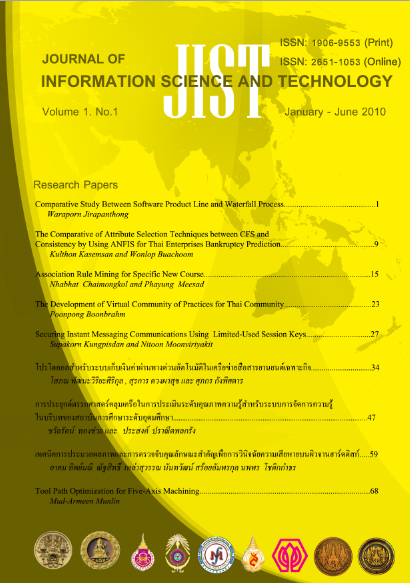Securing Instant Messaging Communications Using Limited-Used Session Keys
Main Article Content
Abstract
- Instant Messaging (or IM for short) is becoming one of the most popular applications on the Internet. Individuals can communicate instantly through a user-friendly graphical user interface over fixed and wireless devices. However, several security issues occur, majorly privacy and authentication. A number of secure IM protocols have been proposed, but they still lack of necessary security properties and acceptable performance. In this paper, we introduce a new secure instant messaging protocol that not only satisfies necessary security properties. Moreover, our analysis shows that the proposed protocol has better transaction performance than existing protocols.
Article Details
This work is licensed under a Creative Commons Attribution-NonCommercial-NoDerivatives 4.0 International License.
I/we certify that I/we have participated sufficiently in the intellectual content, conception and design of this work or the analysis and interpretation of the data (when applicable), as well as the writing of the manuscript, to take public responsibility for it and have agreed to have my/our name listed as a contributor. I/we believe the manuscript represents valid work. Neither this manuscript nor one with substantially similar content under my/our authorship has been published or is being considered for publication elsewhere, except as described in the covering letter. I/we certify that all the data collected during the study is presented in this manuscript and no data from the study has been or will be published separately. I/we attest that, if requested by the editors, I/we will provide the data/information or will cooperate fully in obtaining and providing the data/information on which the manuscript is based, for examination by the editors or their assignees. Financial interests, direct or indirect, that exist or may be perceived to exist for individual contributors in connection with the content of this paper have been disclosed in the cover letter. Sources of outside support of the project are named in the cover letter.
I/We hereby transfer(s), assign(s), or otherwise convey(s) all copyright ownership, including any and all rights incidental thereto, exclusively to the Journal, in the event that such work is published by the Journal. The Journal shall own the work, including 1) copyright; 2) the right to grant permission to republish the article in whole or in part, with or without fee; 3) the right to produce preprints or reprints and translate into languages other than English for sale or free distribution; and 4) the right to republish the work in a collection of articles in any other mechanical or electronic format.
We give the rights to the corresponding author to make necessary changes as per the request of the journal, do the rest of the correspondence on our behalf and he/she will act as the guarantor for the manuscript on our behalf.
All persons who have made substantial contributions to the work reported in the manuscript, but who are not contributors, are named in the Acknowledgment and have given me/us their written permission to be named. If I/we do not include an Acknowledgment that means I/we have not received substantial contributions from non-contributors and no contributor has been omitted.
References
2. TCPdump, http://www.tcpdump.org, last access February, 2010.
3. M. Mannan and P. C. van Oorschot, “Secure Public Instant Messaging”, Proceedings of Financial Cryptography and Data Security 2006.
4. C. H. Yang, T. Y. Kuo, T Ahn, and C. P. Lee, “Design and Implementation of a Secure Instant Messaging Based on Elliptic-Curve Cryptography”, Journal of Computers, Vol. 18(4), January 2008.
5. O. Dandash et al., “Fraudulent Internet Banking Payments Prevention using Dynamic Key,” Journal of Networks, Vol.3(1), Academy Publisher, pp. 25-34, 2008
6. S. Kungpisdan, P.D. Le, and B. Srinivasan, “A Limited- Used Key Generation Scheme for Internet Transactions”, Lecture Notes in Computer Science, Vol. 3325, 2005.
7. S. Kungpisdan and S. Metheekul, “A Secure Offline Key Generation With Protection Against Key Compromise” in the World Multi-conference on Systematics, Cybernetics, and Informatics 2009, Orlando, Florida, July. 2009, pp. 63-67.
8. Li, Y. and Zhang, X., 2004. A Security-enhanced Onetime Payment Scheme for Credit Card. Proc. of the Int’l Workshop on Research Issues on Data Engineering: Web Services for E-Commerce and EGovernment Applications,
9. S. Kungpisdan, B. Srinivasan, and P.D. Le, “Lightweight Mobile Credit-card Payment Protocol”, Lecture Notes in Computer Science, Vol. 2904, pp. 295-308, 2003.
10. A. D. Rubin and R.N. Wright, “Off-line Generation of Limited-Use Credit Card Numbers”, Lecture Notes in Computer Science, Vol. 2339, pp. 196-209, 2002.


